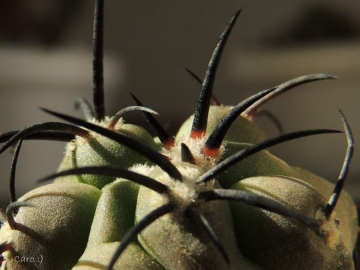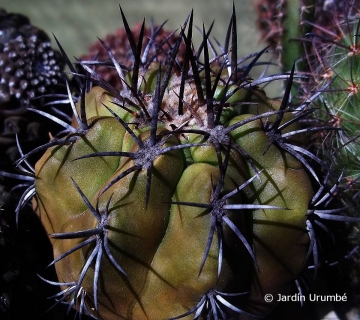
Copiapoa echinoides Photo by: Carolina González
Origin and Habitat: Copiapoa echinoidesSN|1109]]SN|1109]] is endemic to Chile, along the coast from north of Huasco up to 50 km inland in the Atacama region (extent of occurrence of approximately 2,500 km2).
Altitude range: It grows at elevations of 0 to 500 metres above sea level.
Habitat and Ecology: This cactus grows in coastal hills (lomas costeras), on relatively compact and rocky soils. The area is extremely dry with very rare rainfall. The dry season lasts 8 - 12 months and in some years it is possible to have no rainfall at all. Rainfall less than 100 mm/year. The plants obtain water mainly from the condensation of coastal fog (camanchaca). It is not abundant. The only major threat is the widening of roads.
Synonyms:
See all synonyms of Copiapoa echinoides
back
Accepted name in llifle Database:Copiapoa echinoides (Lem.) Britton ex Rose in Britton & RoseCactaceae (Britton & Rose) 3: 88, fig. 100. 1922Synonymy: 14
back
Common Names include:
SPANISH (Español): Duro
SWEDISH (Svenska): Brun randkaktus
UKRAINIAN (Українська): Коп'япоа їжаковидна, Коп'япоа еxіноїдес
Description: Copiapoa echinoidesSN|1412]]SN|1109]] has a flattened globular shape with woolly top, green to brownish epidermis, stout maroon or black spines, usually slightly curved upward and pale yellow flower. It may be solitary or more usually forms dense clusters. This species is closely related to Copiapoa marginataSN|1109]]SN|1412]]. There are many different populations with different characteristics.
Stem: Depressed-spherical to spherical, 7-18 cm across, very firm, green, sometimes brownish and woolly at apex. Only in cultivation plants may have an elongate till columnar shape.
Ribs: 11-17, straight, rounded or truncated.
Areoles: Yellowish, becoming grey with age 2-10 mm apart.
Spines: Brownish-red to black, stout, straight to somewhat curved upward.
Radial spines: 6 to 10 to 2.5 cm long.
Central spines: 0-3 porrect, 1-3(-5) cm long.
Flowers: Pale yellow, scented, 3.5-4 cm long; outer perianth-segments narrowly ovate, acute, reddish; inner perianth-segments broadly oblong, obtuse; scales of ovary and flower-tube.
Fruits: Round, c. 1.5 cm in diameter brownish red, with a few scales.
Seeds: 1.7-2 x 1.3-1.5 mm.
Blooming season: Summer.
Remarks: Small seedlings often change considerably as they grow older which adds to the interest of these plants.
Subspecies, varieties, forms and cultivars of plants belonging to the Copiapoa echinoides group
 Copiapoa bridgesii (Pfeiff.) Backeb.: has very spiny, cylindrical stems. Its relationship with Copiapoa echinoides is unclear. It is probably a good species rather than a variety of C. echinoides. Distribution: North of Chanaral, Atacama, Chile.
Copiapoa bridgesii (Pfeiff.) Backeb.: has very spiny, cylindrical stems. Its relationship with Copiapoa echinoides is unclear. It is probably a good species rather than a variety of C. echinoides. Distribution: North of Chanaral, Atacama, Chile. Copiapoa cupreata (Poselg. ex Rümpler) Backeb.
Copiapoa cupreata (Poselg. ex Rümpler) Backeb. Copiapoa dura F.Ritter: Solitary, or forming dense clumps. The stem is firm, dark tannish-green to very dark-purple and woolly apically. The spines are very strong maroon-reddish to pure black, straight or (usually) somewhat curved upward.
Copiapoa dura F.Ritter: Solitary, or forming dense clumps. The stem is firm, dark tannish-green to very dark-purple and woolly apically. The spines are very strong maroon-reddish to pure black, straight or (usually) somewhat curved upward. Copiapoa echinoides (Lem.) Britton ex Rose in Britton & Rose: small growing plant with dark purplish-brown stem and thick curved amber-maroon to black spines. This appears to be a very variable species.
Copiapoa echinoides (Lem.) Britton ex Rose in Britton & Rose: small growing plant with dark purplish-brown stem and thick curved amber-maroon to black spines. This appears to be a very variable species. Copiapoa echinoides var. cuprea (F.Ritter) A.E.Hoffm.: Stems dull green to dark coppery-brown and woolly apically spines, stout bwown to black, straight to somewhat curved upward.
Copiapoa echinoides var. cuprea (F.Ritter) A.E.Hoffm.: Stems dull green to dark coppery-brown and woolly apically spines, stout bwown to black, straight to somewhat curved upward. Copiapoa griseoviolacea I.Schaub & Keim: has a dark farinose violet-grey epidermis and a dense spine covering. Distribution: south of the Huasco river.
Copiapoa griseoviolacea I.Schaub & Keim: has a dark farinose violet-grey epidermis and a dense spine covering. Distribution: south of the Huasco river.
Bibliography: Major references and further lectures
1) Faundez, L., Walter, H.E., Guerrero, P., Saldivia, P. & Avilés, R. 2013. Copiapoa echinoides. The IUCN Red List of Threatened Species. Version 2014.3. <www.iucnredlist.org>. Downloaded on 08 May 2015.
2) F. Ritter “Kakteen in Sudamerika” Volume 3. 1980
3) A. Hoffmann, H. Walter “Cactáceas en la flora Silvestre de Chile” Ediciones Fundacion Claudio Gay, Santiago, Chile. Second Edition. 2004
4) Charles “Copiapoa. The Cactus file Handbook 4” Cirio Publ. 1998
5) Edward Anderson “The Cactus family” Timber Press, Incorporated, 2001
6) James Cullen, Sabina G. Knees, H. Suzanne Cubey “The European Garden Flora Flowering Plants: A Manual for the Identification of Plants Cultivated in Europe, Both Out-of-Doors and Under Glass” Cambridge University Press, 11/Aug/2011
7) David R Hunt; Nigel P Taylor; Graham Charles; International Cactaceae Systematics Group. "The New Cactus Lexicon" dh books, 2006
8) Wikipedia contributors. "Copiapoa echinoides." Wikipedia, The Free Encyclopedia. Wikipedia, The Free Encyclopedia, 18 Nov. 2014. Web. 8 May. 2015.
9) Urs Eggli, Leonard E. Newton “Etymological Dictionary of Succulent Plant Names.” Birkhäuser 2004
10) N. L. Britton, J. N. Rose “The Cactaceae. Descriptions and Illustrations of Plants of the Cactus Family.” Volume III, The Carnegie Institution of Washington, Washington 1922
11) Michail Belov. "Encyclopedia of the Chilean Flora: Copiapoa echinoides" http://www.chileflora.com Web. 8 May. 2015.
 Copiapoa echinoides Photo by: Carolina González
Copiapoa echinoides Photo by: Carolina González Copiapoa echinoides Photo by: Alexander Arzberger
Copiapoa echinoides Photo by: Alexander ArzbergerCultivation and Propagation: The location has to be warm and bright, and it has to be in direct sun. Otherwise the bodies tend to elongate in cultivation, but they should be protected from excessive heat and sun in summer. In the spring and late summer, water moderately. Between these times there are dry rest periods. In the winter keep the plant absolutely dry. The roots need a lot of room, so make sure that the pot is large enough. Use regular cacti soil with very good drainage.
Propagation: Seeds (offsets rarely), Grafting is often used to speed growth rate of seedlings and to create a back-up to plants in collection.












